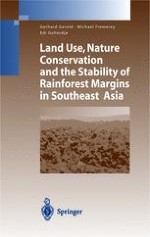2004 | OriginalPaper | Chapter
Land-Use Change, Biodiversity and Ecosystem Functioning in West Kalimantan
Author : Deborah Lawrence
Published in: Land Use, Nature Conservation and the Stability of Rainforest Margins in Southeast Asia
Publisher: Springer Berlin Heidelberg
Included in: Professional Book Archive
Activate our intelligent search to find suitable subject content or patents.
Select sections of text to find matching patents with Artificial Intelligence. powered by
Select sections of text to find additional relevant content using AI-assisted search. powered by
Shifting cultivation is blamed for 50% of all deforestation in Southeast Asia (FAO 1993). Clearly it has had, and will continue to have, a profound impact on the structure and functioning of rainforests. The most obvious changes that occur are a reduction in tree stature and an increase in the grain size of the landscape. These changes are a consequence of an increase in disturbance frequency (return interval shifts from 100s to l0s of years) and spatial scale of disturbance (patch size increases from 10s or 100s to 10,000s of square meters). Less obvious are the longterm shifts in species composition, species diversity, and forest structure that accompany this altered rainforest disturbance regime. Few have documented longterm responses to shifting cultivation, and fewer have taken the next step to determine the consequences of altering forest structure and organization for critical ecosystem functions such as nutrient cycling and maintenance of soil fertility. Understanding changes in biodiversity and ecosystem function within the context of a dynamic human response to economic and ecological drivers is more complex still. The focus of this paper is to address these issues, in answering two questions about rainforest conversion to shifting cultivation: How do centuries of long-fallow shifting cultivation affect tree diversity and soil nutrients?How do current patterns of land-use change affect tree diversity and soil nutrients?
